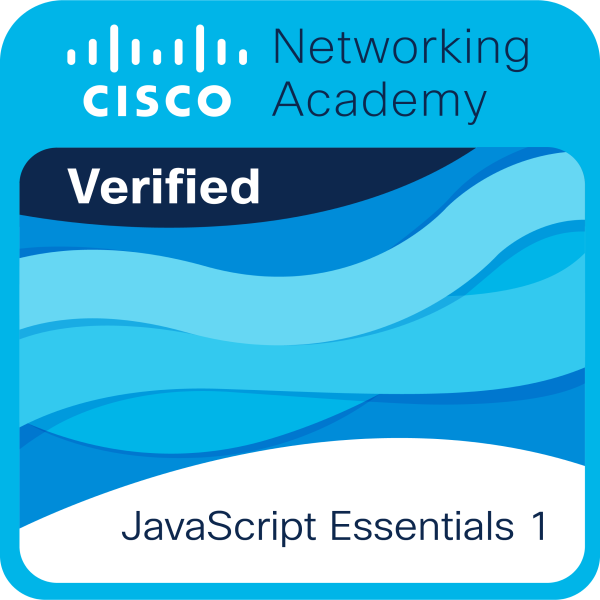Se você está interessado em uma carreira em programação front-end, o JavaScript é essencial para aprender. JavaScript é uma linguagem de programação amplamente utilizada que possibilita incorporar vídeos e caixas de pesquisa em seu site favorito e até mesmo atualizar seu feed de mídia social.
As habilidades de programação abrem você para carreiras em quase todos os setores e são necessárias se você quiser continuar em funções mais avançadas e com maior remuneração na web, aplicativos móveis ou desenvolvimento de jogos. Comece hoje mesmo!
Aqui está o que você aprenderá.
1.0.2 Course Structure
1.0.3 Syllabus
1.0.4 Objectives
1.0.5 Graduate Profile
1.0.6 Prepare for the JSE-40-0x exam
1.1.2 How to communicate with the computer
1.1.3 JavaScript as an interpreted language
1.1.4 A few more words on JavaScript
1.1.5 Client-side vs server-side programming
1.1.6 Is this the perfect programming language? – disadvantages
1.1.7 Is this the perfect programming language? – advantages
1.1.8 Let's get ready to work
1.2.2 Online development environment
1.2.3 Local development environment
1.2.4 Code editor
1.2.5 Interpreter
1.2.6 Debugger
1.3.2 Online development environment
1.3.3 Local development environment
1.3.4 The script tag
1.3.5 ... and a little something about CSS
1.3.6 How can we run our JavaScript code?
1.3.7 Okay, maybe we could finally run something...
1.3.8 Executing the code directly in the console
1.3.9 SECTION SUMMARY
1.3.10 SECTION QUIZ
2.0.2 Naming the variables
2.0.3 Declaring variables
2.0.4 Initializing variables
2.0.5 Declarations and strict mode
2.0.6 Changing variable values
2.0.7 Constants
2.0.8 Scope
2.0.9 A brief word about functions
2.0.10 The var keyword - continued
2.0.11 Variable shadowing
2.0.12 Hoisting
2.0.13 SECTION SUMMARY
2.0.14 SECTION QUIZ
2.0.15 LAB Variables
2.1.2 The typeof operator
2.1.3 Primitive data types
2.1.4 Type conversions
2.1.5 Conversions
2.1.6 Conversion to String
2.1.7 Conversion to Number
2.1.8 Conversion to Boolean
2.1.9 Conversion to BigInt
2.1.10 Implicit Conversions
2.1.11 SECTION PRACTICE
2.2.2 What can arrays be useful for in practice?
2.2.3 SECTION PRACTICE
2.2.4 SUMMARY
2.2.5 LAB Data Types
2.3.2 But why comment in the first place?
2.3.3 SECTION SUMMARY
2.3.4 SECTION PRACTICE
3.0.2 Assignment operators
3.0.3 Arithmetic operators
3.0.4 Unary arithmetic operators
3.0.5 Unary increment and decrement operators
3.0.6 Compound Assignment Operators
3.0.7 Logical operators
3.0.8 Logical operators and non-Boolean values
3.0.9 Compound Assignment Operators
3.0.10 SECTION PRACTICE
3.1.2 Comparison operators
3.1.3 Other operators
3.1.4 Precedence
3.1.5 SECTION SUMMARY
3.2.2 Dialog box
3.2.3 SECTION SUMMARY
3.2.4 SECTION PRACTICE
3.2.5 LAB Interaction
4.0.2 The if statement
4.0.3 The if ... else statement
4.0.4 The if … else … if statement
4.0.5 Conditional operator
4.0.6 The switch … case statement
4.0.7 SECTION SUMMARY
4.0.8 SECTION PRACTICE
4.0.9 LAB Conditional execution
4.1.2 The while loop
4.1.3 The do … while loop
4.1.4 The for loop
4.1.5 Loops and arrays
4.1.6 for … of
4.1.7 for … in
4.1.8 The break and continue statements
4.1.9 The break keyword
4.1.10 SECTION SUMMARY
4.1.11 SECTION PRACTICE
4.1.12 LAB Loops
5.0.2 Declaring functions
5.0.3 Calling functions
5.0.4 Functions – local variables
5.0.5 The return statement
5.0.6 Parameters
5.0.7 Shadowing
5.1.2 Recursion
5.1.3 Functions as first-class members
5.1.4 Function expressions
5.1.5 Callbacks
5.1.6 Asynchronous callbacks
5.1.7 setTimeout and setInterval functions
5.1.8 Arrow functions
5.1.9 SECTION SUMMARY
5.1.10 SECTION PRACTICE
5.1.11 LAB Functions (Part 1)
5.1.12 LAB Functions (Part 2)
6.0.2 Natural languages and communication errors
6.0.3 Errors and exceptions in JavaScript
6.0.4 Errors without exceptions?
6.0.5 Limited confidence
6.1.2 The try...catch statement
6.1.3 Conditional exception handling
6.1.4 The finally statement
6.1.5 Why should we use a finally block?
6.1.6 The throw statement and custom errors
6.1.7 SECTION SUMMARY
6.1.8 SECTION PRACTICE
6.2.2 Debugging
6.2.3 Step-by-step program execution
6.2.4 Preparation of the environment and an example
6.2.5 Use of the debugger statement
6.2.6 Resume execution
6.2.7 How to deal without the debugger statement
6.2.8 Step over
6.2.9 Step into
6.2.10 Call stack
6.2.11 Step out
6.2.12 SECTION SUMMARY
6.2.13 SECTION PRACTICE

